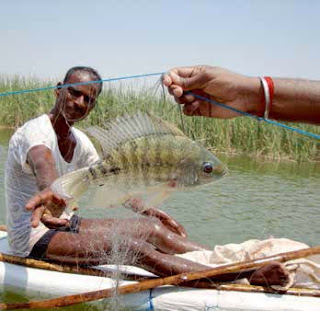by Dr B Laxmappa, Fisheries Development Officer, Department of Fisheries, India
First published in International Aquafeed, July-August 2015
Tilapia are now the world’s second most popular group of farmed fish after carp. Worldwide production exceeded 3.9 million tonnes in 2012 according to FAO and demand continues at a steady pace. Geographically Tilapias are the most widespread species for aquaculture production in the world. Tilapia, a native to Africa and Middle East has emerged as one of the most internationally traded food fishes in the World. Around 20 countries are farming Tilapia, with China, Egypt, Indonesian Philippines, Thailand and Brazil taking the lead.
Tilapia belongs to the family Cichlidae under order Perciformes and has recently been classified into three genera, based on parental incubation of eggs. The species of the genera Sarotherodon and Oreochromis are mouth brooders, while Tilapia incubate eggs in a ‘nest’ built on the bottom of a lake or pond. There are about 70 species of Tilapia, of which eight species are used in aquaculture worldwide (Table: 1). One of the eight cultured species is Nile Tilapia, a relatively large cichlid fish introduced to several countries outside its natural range e.g. Brazil, Australia, Bangladesh, Sri Lanka and India.
Present status
India is a vast country in terms of natural resources and considered one of the most biodiverse countries in the world. The Indian mainland is drained by 15 major, 45 medium and over 120 minor rivers, besides numerous ephemeral streams. The diverse river systems in India harbour one of the richest fish germplasm resources in the world. Official records show that O. mossambicus was first introduced to India from Sri Lanka in 1952 and thereafter stocked in several reservoirs in southern India for production enhancement.
O. niloticus was introduced to India in late 1987. The aquaculture of O. niloticus expanded in the southern region of the country, especially by private entrepreneurs. In 1995, Vorion Chemicals Ltd. Chennai claimed high production of hybrid red Tilapia, popularly known as golden Tilapia. However, production collapsed for unknown reasons. Culture of O. niloticus is now gearing up, particularly in Andhra Pradesh, Orissa and West Bengal, and the fish is now distributed to many states particularly the coastal areas.
Cultivated Tilapia are typically hybrids between O. niloticus and other closely related species native to Africa. O. niloticus are one of the easiest and most profitable fish to farm, in part because they are omnivorous and can be fed a diet derived exclusively from plants. O. niloticus and other fish that feed on vegetable materials offer a much more ecologically sound and environmentally friendly means of providing humankind with an abundance of nutritious and delicious fish. There have been frequent escapes of Tilapia from aquaculture facilities due to recurring floods or inadvertent releases. Tilapia now forms a part of the fish fauna in the Godavari, Krishna, Cauvery, Yamuna and Ganga Rivers.
Read the full article in International Aquafeed HERE.
First published in International Aquafeed, July-August 2015
Tilapia are now the world’s second most popular group of farmed fish after carp. Worldwide production exceeded 3.9 million tonnes in 2012 according to FAO and demand continues at a steady pace. Geographically Tilapias are the most widespread species for aquaculture production in the world. Tilapia, a native to Africa and Middle East has emerged as one of the most internationally traded food fishes in the World. Around 20 countries are farming Tilapia, with China, Egypt, Indonesian Philippines, Thailand and Brazil taking the lead.
Tilapia belongs to the family Cichlidae under order Perciformes and has recently been classified into three genera, based on parental incubation of eggs. The species of the genera Sarotherodon and Oreochromis are mouth brooders, while Tilapia incubate eggs in a ‘nest’ built on the bottom of a lake or pond. There are about 70 species of Tilapia, of which eight species are used in aquaculture worldwide (Table: 1). One of the eight cultured species is Nile Tilapia, a relatively large cichlid fish introduced to several countries outside its natural range e.g. Brazil, Australia, Bangladesh, Sri Lanka and India.
Present status
India is a vast country in terms of natural resources and considered one of the most biodiverse countries in the world. The Indian mainland is drained by 15 major, 45 medium and over 120 minor rivers, besides numerous ephemeral streams. The diverse river systems in India harbour one of the richest fish germplasm resources in the world. Official records show that O. mossambicus was first introduced to India from Sri Lanka in 1952 and thereafter stocked in several reservoirs in southern India for production enhancement.
O. niloticus was introduced to India in late 1987. The aquaculture of O. niloticus expanded in the southern region of the country, especially by private entrepreneurs. In 1995, Vorion Chemicals Ltd. Chennai claimed high production of hybrid red Tilapia, popularly known as golden Tilapia. However, production collapsed for unknown reasons. Culture of O. niloticus is now gearing up, particularly in Andhra Pradesh, Orissa and West Bengal, and the fish is now distributed to many states particularly the coastal areas.
Cultivated Tilapia are typically hybrids between O. niloticus and other closely related species native to Africa. O. niloticus are one of the easiest and most profitable fish to farm, in part because they are omnivorous and can be fed a diet derived exclusively from plants. O. niloticus and other fish that feed on vegetable materials offer a much more ecologically sound and environmentally friendly means of providing humankind with an abundance of nutritious and delicious fish. There have been frequent escapes of Tilapia from aquaculture facilities due to recurring floods or inadvertent releases. Tilapia now forms a part of the fish fauna in the Godavari, Krishna, Cauvery, Yamuna and Ganga Rivers.
Read the full article in International Aquafeed HERE.
The Aquaculturists
This blog is maintained by The Aquaculturists staff and is supported by the
magazine International Aquafeed which is published by Perendale Publishers Ltd
For additional daily news from aquaculture around the world: aquaculture-news


No comments:
Post a Comment